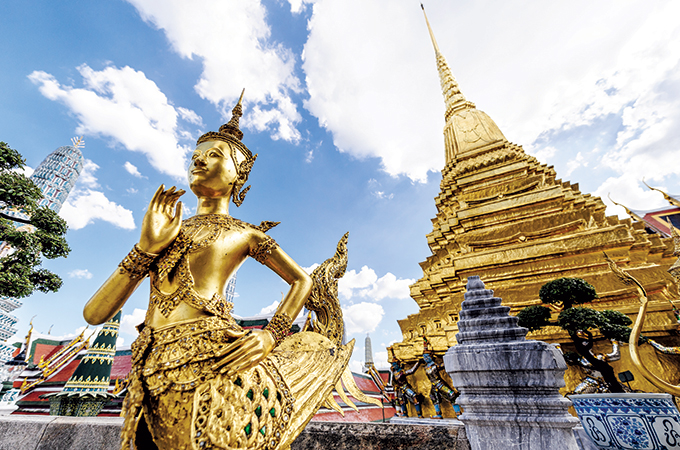
Asean (Association of Southeast Asian Nations) countries are being encouraged to improve their infrastructure to enable accessibility for all travellers, including those with disabilities and senior citizens, and to join forces to woo niche market segments including Muslims.
TTN, one of the few Middle East publications hosted by the Asean Tourism Forum (ATF) held in Chiang Mai, Thailand from January 22 to 26, witnessed a refreshing call for more inclusive tourism after the 21st Meeting of Asean Tourism Ministers, one of the most important elements of the ATF.
Chaired by Weerasak Kowsurat, Minister for Tourism and Sports of Thailand, other areas to focus on for promoting accessible and inclusive tourism were in cruise and gastronomy tourism, tourism investment, sustainable development and overland cross-border travel.
The Asean region registered 126 million international arrivals, indicating that tourism to the region grew by 8.4 per cent from 2016. Thailand alone received more than 35 million arrivals.
In other meetings with airlines, national tourism organisations (NTOs) and other travel industry professionals, the Asean Tourism Association (ASEANTA) discussed ways of improving cooperation throughout the region, including intra-Asean travel for the growing Muslim sector. The board also spoke with the Asean Hotels and Restaurant Association on achieving ways of being more Muslim-friendly, such as increasing accessibility to halal food.
The annual ATF, this year held under the theme “Asean – Sustainable Connectivity, Boundless Prosperity”, is designed to promote tourism to and within the Asean. It is hosted on a rotational basis among the 10 countries that make up the region - Brunei, Cambodia, Indonesia, Laos, Malaysia, Myanmar, Philippines, Singapore, Thailand and Vietnam.
The 37th edition was held at the Chiang Mai International Exhibition and Convention Centre (CMECC) as part of Thailand’s policy to promote its secondary destinations. Conferences, seminars and the Travel Exchange (TRAVEX) trade fair organised by the Tourism Authority of Thailand (TAT) attracted 240 buyers of which 15.0 per cent came from Asia Pacific, 47.3 per cent from Europe, 2.4 per cent from Middle East, 4.0 per cent Oceania, 3.0 per cent Africa, and 8.6 per cent from North and South America. There were 650 sellers and 894 exhibitors.
TAT plans to promote sustainable tourism where the local community is the ultimate beneficiary. “We believe this will pave the way for Thailand to be a preferred destination among international visitors,” said Yuthasak Supasorn, TAT governor. Encouraging sustainability, 19 awards were presented at the inaugural Asean Sustainable Tourism Awards (ASTA) which will run every two years as part of the Asean Tourism Strategic Plan 2016-2025.
Supasorn added, “Because each of the Asean countries is unique its own way, the tourism products, plans and policies are all similarly unique. However, it is the combined power of these individual policies, especially those related to facilitation and connectivity that makes Asean such a popular and rapidly-growing destination.”
Improved air links between the Middle East and Asean countries has encouraged more tourist traffic between the two regions. In May last year Royal Brunei Airlines and Turkish Airlines enhanced a code share agreement allowing Turkish Airlines to run flights between Singapore and Istanbul and for Royal Brunei Airlines to operate flights between Singapore and Bandar Seri Begawan. In July last year Emirates Airline launched daily flights from Dubai to Phnom Penh and Yangon and in the same month introduced two daily services between Dubai and Bali.
According to Tanes Petsuwan, TAT deputy governor for marketing communications, the four times weekly direct service from Doha to Chiang Mai launched in December 2017 by Qatar Airways brought “significant new sources of traffic by allowing visitors from Europe, the Middle East and Africa to connect to the northern Thai city via the airline’s hub in Qatar”.
Each country has more than one unique selling point, and Thailand’s reputation as a top wedding destination prevails. TAT co-hosted the first ever Amour Asia Pacific 2018, a luxury travel trade event designed for the elite romance travel market last month (February) in Bangkok.
Myanmar based Hla Aye, managing director, Shan Yoma Travel & Tours, believes that hot air ballooning above Bagan’s 2,000 pagodas and a luxury river cruise from Bagan to Mandalay would appeal to Middle East clients. The country is expecting to double visitor numbers to 7.2 million visitors by 2020 as connectivity improves.
Brunei, with its 70 per cent Muslim population, is marketing its natural and cultural attractions. Anthony Chieng Hock Kiet, managing director, Uluulu National Park Resort in Temburong is encouraging low-key eco-tourism. “The Middle East market is limited in this regard,” he said, “Unless visitors are looking for balance. We offer an experience far away from shopping and nightlife – we welcome visitors that enjoy the slow pace.”
The Tourism Promotions Board (TPB) Philippines continues with its Bring Home a Friend Programme, aimed at Filipinos working abroad. “They act as our ambassadors,” said Monica May R.St. Ana, marketing specialist, TPB. “They get incentives such as land, a car or other gifts, by bringing home a foreigner.” She added that the board would aim at intensifying its online presence to attract more Middle East clients.
During ATF, the Pacific Asia Travel Association (PATA) announced that the PATA Destination Marketing Forum 2018 will be held in Khon Kaen in the north eastern region of Thailand from November 28 to 30.